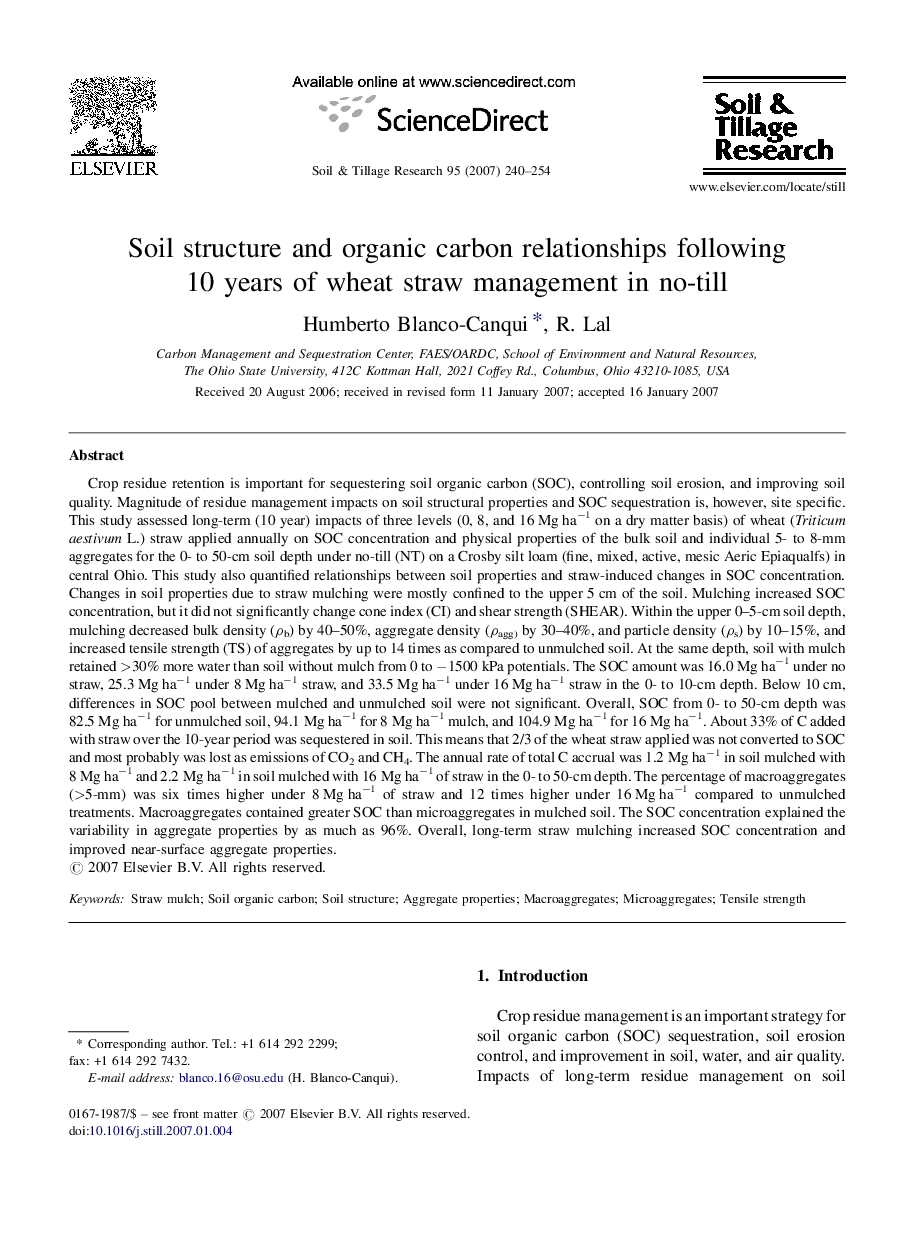| کد مقاله | کد نشریه | سال انتشار | مقاله انگلیسی | نسخه تمام متن |
|---|---|---|---|---|
| 306695 | 513109 | 2007 | 15 صفحه PDF | دانلود رایگان |

Crop residue retention is important for sequestering soil organic carbon (SOC), controlling soil erosion, and improving soil quality. Magnitude of residue management impacts on soil structural properties and SOC sequestration is, however, site specific. This study assessed long-term (10 year) impacts of three levels (0, 8, and 16 Mg ha−1 on a dry matter basis) of wheat (Triticum aestivum L.) straw applied annually on SOC concentration and physical properties of the bulk soil and individual 5- to 8-mm aggregates for the 0- to 50-cm soil depth under no-till (NT) on a Crosby silt loam (fine, mixed, active, mesic Aeric Epiaqualfs) in central Ohio. This study also quantified relationships between soil properties and straw-induced changes in SOC concentration. Changes in soil properties due to straw mulching were mostly confined to the upper 5 cm of the soil. Mulching increased SOC concentration, but it did not significantly change cone index (CI) and shear strength (SHEAR). Within the upper 0–5-cm soil depth, mulching decreased bulk density (ρb) by 40–50%, aggregate density (ρagg) by 30–40%, and particle density (ρs) by 10–15%, and increased tensile strength (TS) of aggregates by up to 14 times as compared to unmulched soil. At the same depth, soil with mulch retained >30% more water than soil without mulch from 0 to −1500 kPa potentials. The SOC amount was 16.0 Mg ha−1 under no straw, 25.3 Mg ha−1 under 8 Mg ha−1 straw, and 33.5 Mg ha−1 under 16 Mg ha−1 straw in the 0- to 10-cm depth. Below 10 cm, differences in SOC pool between mulched and unmulched soil were not significant. Overall, SOC from 0- to 50-cm depth was 82.5 Mg ha−1 for unmulched soil, 94.1 Mg ha−1 for 8 Mg ha−1 mulch, and 104.9 Mg ha−1 for 16 Mg ha−1. About 33% of C added with straw over the 10-year period was sequestered in soil. This means that 2/3 of the wheat straw applied was not converted to SOC and most probably was lost as emissions of CO2 and CH4. The annual rate of total C accrual was 1.2 Mg ha−1 in soil mulched with 8 Mg ha−1 and 2.2 Mg ha−1 in soil mulched with 16 Mg ha−1 of straw in the 0- to 50-cm depth. The percentage of macroaggregates (>5-mm) was six times higher under 8 Mg ha−1 of straw and 12 times higher under 16 Mg ha−1 compared to unmulched treatments. Macroaggregates contained greater SOC than microaggregates in mulched soil. The SOC concentration explained the variability in aggregate properties by as much as 96%. Overall, long-term straw mulching increased SOC concentration and improved near-surface aggregate properties.
Journal: Soil and Tillage Research - Volume 95, Issues 1–2, September 2007, Pages 240–254